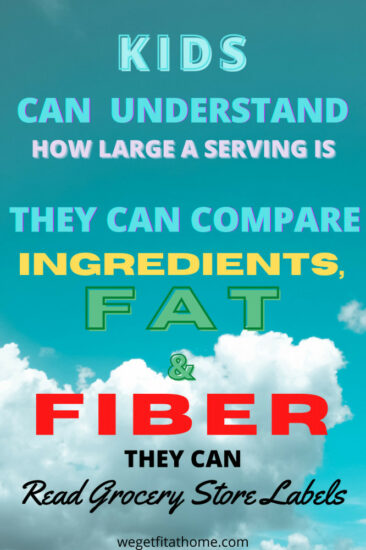We should all be aware of the labels on the foods we purchase in the grocery store. Labels are so valuable in telling us how to plan a healthy diet. So, what are 5 things you should understand on a food label?
There are four things you will see on a nutrition label. You will see serving size, calories, percentage of Daily Value and core nutrients. In addition to a Nutrition Label, you will see an Ingredient List.
1-Serving Size
The food label lists the serving size. It tells you how many nutrients are in a serving of food. Some serving sizes are 1 cup, some serving sizes are a half of a cup, etc.
If you have cookies, the label will tell you how much is in a serving, and how many calories are in a serving as well as how many other nutrients are in the cookies.
2-Total Calories in a Single Serving
Take a package of 12 cookies, listed as 300 calories per serving. However, the serving size is three cookies. If you eat the entire pack of cookies, you ate a whopping 1200 calories, instead of just 300 calories for one serving.
Compare the amount you usually eat with the serving size listed on the package. If it lists one serving as a cup and you usually eat two cups, you, in fact, are getting two servings. You are getting twice the calories, fat, and other nutrients as listed on the label.
3-Percent Daily Values (DV)
Other information on the label is in the form of a percentage.
Nutrients such as fat, protein, carbohydrates, and fiber,
Vitamins such as vitamin A and C
Minerals such as calcium and iron are listed as a percentage of your recommended requirements for the day.
Use the percent Daily Values (DV) to help you evaluate just how each food will fit into your daily meal plan.
Daily Values are an average percent of nutrients for a person consuming 2,000 calories each day. A food containing 10% DV of fat, contains 10% of the total fat a person consuming 2,000 calories each day should eat.
Low Percentage and High Percentage
It is noteworthy that percentages help you evaluate how a particular food fits into your daily meal plan. You should consider the percentages in each food.
Decrease the percentage of saturated fat, trans fat, cholesterol, and sodium in your diet. That LOW percentage of these should be 5% or less.
Increase your consumption of vitamins, minerals, and fiber in your diet. A HIGH percentage of vitamins, minerals, and fiber is 20% or more.
4-Core Nutrients
Someone described core nutrients as the ones which provide calories such as: Protein, Fat and Carbs.
The core nutrients listed on the labels of the food we purchase in the grocery store include fat, saturated fat, trans fat, cholesterol, sodium, carbohydrate, fiber, sugars, protein, vitamin A, vitamin C, calcium, and iron.
This labeling is done consistently across packaging, so it is easy to compare between different food products.

5-The Ingredient List
The ingredient list is another important part of the label. Foods with more than one ingredient must have an Ingredient List on the label. Ingredients are listed according to weight.
The ingredients that are at the beginning of the list – first, second, third, will contain more than the amount of the ingredients listed at the end of the ingredient list.
Pay close attention where sugar comes on the Ingredient List. Is sugar one of the first ingredients in the list?
Limit sugar (also called fructose corn syrup), corn syrup, sucrose, or glucose. If sugar is one of the first ingredients in the list, you may want to be sure to limit or avoid that product.
Some Nutrition Terms to Consider
Low Calorie
- 40 calories or less per serving
Low Cholesterol
- 20 milligrams or less of saturated fat per serving
Reduced
- At least 25% less of the nutrient or calories than normal
Good Source of
- Contains at least 10 to 19% of a Daily Values of a specific vitamin or nutrient per serving.
Excellent Source of
- Provides at least 20% or more of a Daily Value of a specified nutrient/serving.
Fat Free or Sugar Free
- Less than ½ gram of fat or sugar per serving.
Low Sodium
- 140 Milligrams or less of sodium per serving
Organic
- To have a USDA label that says organic, 95% or more of the ingredients must have been grown or processed without synthetic fertilizers or pesticides. (among other standards)
Servings per Package
The label sometimes tells you how many servings are in each package of food. Math comes in handy when serving a group of people.
If there are 15 servings in a package, and there are two items per serving, with a simple calculation you will know how many packages are necessary to feed the group.
Grams or Ounces
A nutrition label is like a table of contents. It tells you what is inside the food that is in the package. It helps you make good decisions about how healthy the food is to your diet.
In some countries, food is measured in grams, also written as g. Some nutrients are measured in milligrams, or mg. Milligrams are very tiny. There are 1,000 milligrams in 1 gram.
Other countries measure in ounces, also written as oz.
5 Things You Should Understand on a Food Label
Food labels are calculated on a 2,000 calorie intake of an adult. It is not calculated on the size of a growing child.
However, kids can read food labels. There are things they can learn from food labels.
Kids Can Understand How…
- Large is a serving.
- Many calories are in a serving.
They Can Compare Foods That Have More…
- Fiber
- Fat
- Calories per serving
What is the 5/20 rule in the context of food labels?
Undeniably, the 5/20 rule is not the perfect test, but it does give you a quick rule to go by. When reading a food packaging label, if the percentage of Daily Values (DV) is less than 5% it is a low
value of the nutrient. If it is greater than 20 % there is a high
percentage of that nutrient in the food.
Reading Labels Can be Tricky.
Manufactures sometimes use tantalizing tactics to catch your attention and convince you to buy their products.
These products may not always be as healthy as they are labeled, making it hard for the consumer to understand what their claims really mean.
One of the best tips to be aware of is to ignore the manufacturer’s impressive claims on the front of the package. Choose instead to study the ingredient list.
Front labels on a package are often used as a good sales ploy, however they are often misleading, as in the case of sugary breakfast cereals.
What Does it Really Mean?
“Made with real ingredients”, is not a properly regulated term. It is purely there to catch your eye. The same goes for “all natural”. Legally they mean nothing.
Ingredients are listed by quantity from heaviest to the lightest. Usually, the product’s main ingredients are the first 3 ingredients listed.
Look for a healthier alternative if sugar is one of the first three ingredients listed.
Some of the most Misleading Packaging Claims
Multigrain
Multigrain sounds very healthy. It however just means that the product is made from more than one grain. It may still be highly processed. Look at the Ingredient List to see if it is listed as whole grain.
Organic
The label organic can be very misleading. Organic does not have to mean healthy. Organic sugar is still sugar!
Low-calorie
Low calorie products must have one-third fewer calories than the brand’s original product. One brand’s “low-calorie” item may contain a similar quantity of sugar as another brand’s original item.
Made with whole grains.
Unless the whole grains are in the first three items in the ingredient list, the whole grains are probably negligible.
Gluten-free
Gluten-free products do not contain certain grains. They may still be highly processed and contain excessive amounts of fats.
Fruit-flavored
Many processed foods with the label fruit-flavored may not contain any real fruit, only chemically processed flavors to resemble the flavor.

In Conclusion
What are 5 things you should understand on a food label? Serving size, calories, percentage of Daily Value and core nutrients are four of the things you will find on a Nutrition label. Additionally, you will see an Ingredient List.
The first 3 ingredients on the Ingredient list, are the main ingredients of the product.
There are many healthy foods out there for you to enjoy and feed your family. Just be alert and read the labels carefully.
Please Leave a Comment
I would love to hear from my readers! Do you read the labels on grocery items when you go grocery shopping?
Disclaimer: If you have any concerns or questions about your health, you should always consult with a physician or other healthcare professional. No content on this site should be substituted for direct medical advice from your doctor or other qualified healthcare practitioner. The information contained here is for informational purposes only. It is from my research and personal experience.


Hi, Carolyn!
Glad to see your introduction about 5 Things You Should Understand on a Food Label.
Food labels are really important. It can not only indicate the ingredients of the food, but also contain calories, and so on. This allows potential customers to fully understand the properties of the food and whether it is suitable for them, so as to make a choice.
In addition, you explain a lot of technical terms. This is good so that non-professionals can understand what the label means.
It’s a great article, thank you!
Harry
It does help to know what is in the food you eat, just like people like to know what is under the hood of their car! If we know what we are eating, we can plan to steer clear of excess sugar and salt. Diabetics need to keep track of their carbohydrates, and people with heart disease need to keep track of their cholesterol so they stay as healthy as possible. It is to our benefit that we have labels on the food that we buy from the store.
Hello there! This is an informative post! These days I feel like I’ve been taking the nutrition fact label for granted. Although I don’t really have any health concerns at the moment, I shouldn’t take health for granted either. I feel like diabetes, cholesterol, and high blood pressure are very common illnesses that can affect anyone. What better way than to look at the nutrition facts label? I feel like that alone can give a lot of information on what illnesses it can exacerbate. By reading the label, one can take the necessary steps to determine which foods are appropriate to consume. Thanks for creating this.
Hi Mike, and thanks for stopping by with a comment! As the saying goes “You are what you eat”. If we want continued health in the future it is good to take advantage of good nutrition now. Salt and sugar are two of the most likely ingredients to effect our health. It pays to take care of our health before we need to undo our poor eating habits!